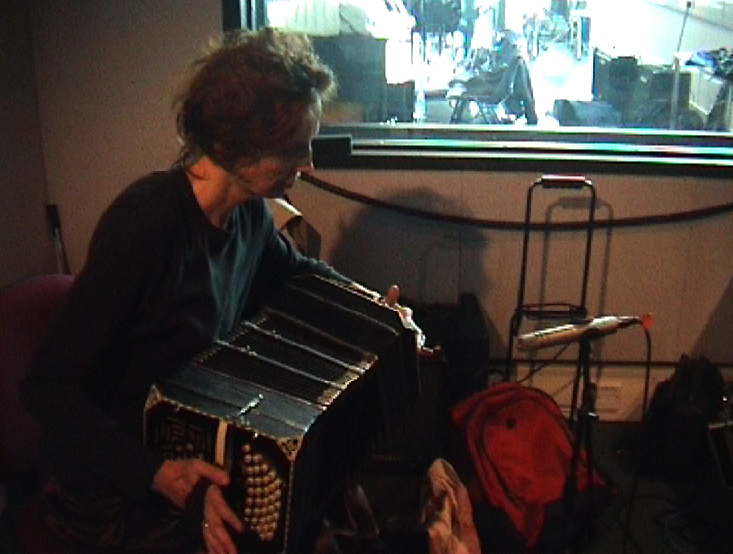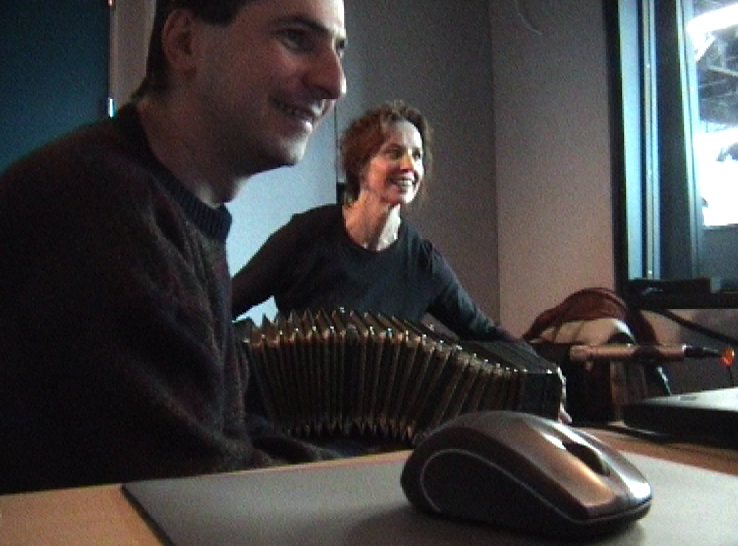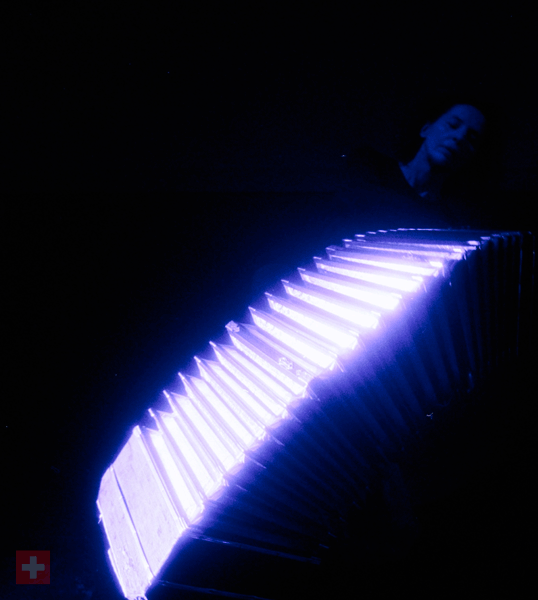Design And Performance Lab
|
UKIYO (Moveable World) .
Caroline Wilkins and Oded Ben-Tal enjoying the interfacesession between Caroline's instrument and Oded's digital program .(c) DAP-Lab, 2009
conceptual notes by Caroline Wilkins
The bandoneon was invented in 1845 by Heinrich Band in Krefeld, Germany, as an improvement on the already-existing concertina. It is essentially a tactile instrument, with two resounding boxes to the left and right of a long bellows. Essentially it is anthropomorphic, functioning only by means of air like a human being, and producing a raw, reedy timbre. In his work "Pandorasbox. Bandoneonpiece" (1960). Composer Mauricio Kagel explores a new kind of virtuosity, in homage to the pianist David Tudor, that plays with all the possibilities of its sound-production. It is exactly this kind of approach that has determined my fascination for the instrument: to re-discover it by other means than the conventional training offered by traditional playing methods. By its intrinsic mechanism the bandoneon takes time to react to the pull/push of its bellows, the air stream carrying the sound from reeds opening and shutting inside the casing. There is a certain attack/delay effect, a link with the human in-breath/out-breath, an "effort" of difficult breathing. The instrument creates and discovers space through its breath. It "inspires", blows in, breathes. The player and instrument become one in a mixture of organic form and object, constantly changing roles. Their relationship is essentially intimate. The visual interaction between body and instrument, gesture and movement, are intrinsically linked with the sounds produced. Sitting on a floor immediately releases me from the conventions of traditional musician practice, and allowed the instrument to become an extension of my body. A more direct inter-action with the dancers/performers and relayed sounds / images, becomes possible. In this combination of gesture and sound issuing from my performance I sometimes feel like a catalyst mediating between the other elements. Returning to the aspect of instrument and performer becoming "one", I would define this as a constant shift between the animate and inanimate, as though the bandoneon, by its innate structural flexibility, takes on its own directional movement and obliges me to follow accordingly. There is almost a sense of "loss of control" on my part as I negotiate its physical mass and presence as a moving object, with that of my own body - a state of flux between the two. During a recording session with Oded Ben-Tal, responsible for the sound and music design, we discussed the possibilities of incorporating both live and pre-recorded sound produced by the bandoneon, together with live electronics, developing and modifying the original instrumental timbres and amplifying some of the live percussive / air sounds so as to make them sufficiently audible during a performance. The live electronics would respond to certain pitches produced by the instrument, triggering off a palette of extended sounds and filling a longer silence with air sound. They open up the possibility of another dimension of space within live musical performance, that of a virtual presence together with the physical presence of a live instrument.
photoprocessing by Paul Verity Smith (c) DAP Lab 2009
For the development of the choreographic installation and its sonic interfaces , go to the February/March 2009 workshop images:
This research project is funded by a PM12 Connect/British Council Grant and a RDF (Brunel University) grant. dance tech network site of Ukiyo project
All photos (c) DAP-Lab
a new project created in a research collaboration between DAP-Lab and Keio University / Inetdance Japan
all images from the new rehearsals and software design devopment at DAP Lab Studio (c) 2008 DAP Lab & Keio University/ inetdance
Further notes on design and performance concepts are published on this site. (c) dap 2007-08
Project directors: Johannes Birringer & Michèle Danjoux Brunel University, West London
|
 .
.  .
. 
